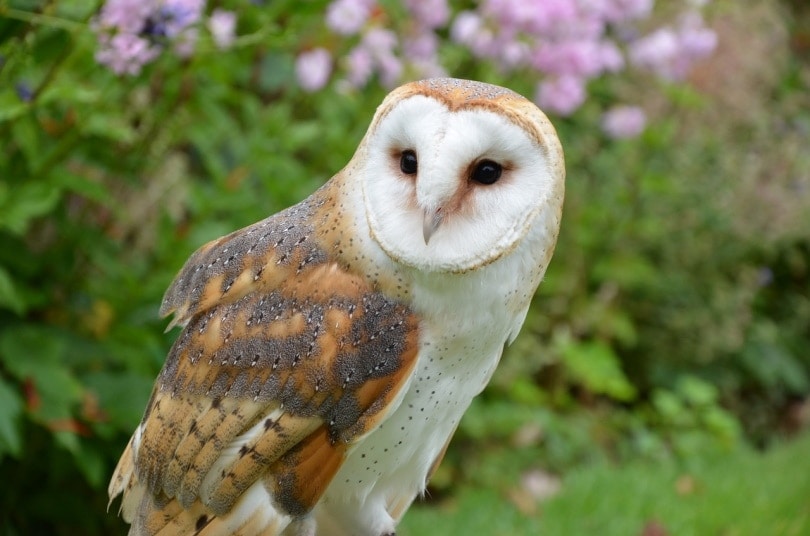Are Owls Smart? Here’s What Science Tells Us
Last Updated on

Comparing different species, or even seeing how an animal stacks up to our intelligence, is something people often do. It’s a correlation that makes scientists cringe because it smacks of anthropomorphism or gives human qualities to other creatures. It’s the proverbial apple and orange discussion.
Even contrasting owls with other birds is fraught with problems. These animals are inherently different from other species. They don’t communicate like songbirds do, an example of their social intelligence. That’s one of the three criteria researchers use to quantify intellect. Owls don’t learn words or have the same tool use capabilities as parrots.
Therefore, the best assessment we can give of owl intelligence is that owls are good at fulfilling their role in the ecosystem. Some would consider these birds smart by that definition. Let’s delve further into this question and describe it by the owl’s standards.

Other Signs of Intelligence
The other two criteria for intelligence are concept formation and problem-solving. The former is connecting the dots. An animal observes different stimuli and consequences. It can then take this information and make associations that can benefit the creature.
For example, the Little Owl makes holes for storing food. The aptly named Burrowing Owl takes over abandoned prairie dog tunnels for their use. It’s worth noting that these two species are of the same genus.
However, the owl isn’t at the head of the class when it comes to problem-solving skills. Researchers consider these abilities with a series of tests involving Great Grey Owls. They baited strings that the birds would have to pull to get the reward. Only 50% figured out the puzzle, in odds no better than chance. These findings fly in the face of the wise owl image from Greek mythology.

Defining the Owl
We’ve seen that evolution hasn’t divvied out intelligence equally to owls. Bear in mind that the challenges an organism faces to survive will drive the adaptations that stick. We see it with owls on full display. While many think of these birds as strictly nocturnal, some are diurnal, such as the Snowy Owl. Others, like the Eurasian Eagle Owl, are active at dusk and dawn or crepuscular.
We may consider owls intelligent simply because they’re so skilled at what they do, no matter what time of day they hunt. We can see excellent examples in the birds’ anatomy and behavior that make a strong case for their competitive edge as predators. They also show how owls make great use of what they have.

Owl Anatomy
Owls differ from most avian species because of their faces and forward-facing eyes, like humans. These factors help these birds hunt better with their superior sight and hearing. Owls are farsighted with an outstanding ability to distinguish moving objects in their environment, as evidenced by the Barn Owl. Many species have asymmetrical ears that give them the ability to hone in on sounds.
Owls are surprisingly stealthy despite the size of some of the larger species, such as the Great Horned Owl. This bird weighs in at nearly 4 pounds with up to a 60-inch wingspan. Yet, this predator can quietly navigate through its forest habitat to take its prey, relying primarily on a surprise attack. We can call owls intelligent just because they do their jobs so well. Mice and other rodents are fair game.

Owl Behavior
Other examples of owl behavior also suggest excellent cognitive abilities. The Little Owl we discussed earlier has up to 40 different vocalizations. That shows some communication capabilities. Barn owls can switch their sensory focus to hearing prey if their vision is compromised. Adult owls feed their slightly older and stronger owlets over the smaller ones that are less likely to survive.
These things may show some decision-making.
Many species are relatively long-lived, such as the Great Horned Owl, with one bird living 28 years. That often equates with a higher parental investment. The chicks are born altricial, meaning they are helpless when they hatch. However, they don’t remain that way long. Owlets grow rapidly. That balances the young’s initial development stage.
It’s worth noting that many species we consider intelligent by various criteria, like chimpanzees, gorillas, and elephants—even humans—have a similar development pattern.

Summary
People have looked up to the owl as the prime symbol of intelligence for centuries. While these birds can’t talk or form elaborate social groups as other species, they are highly specialized for their roles as top predators in the food chain. They possess the skills they need to succeed. Owls have different cognitive abilities where it helps their survival.
We’ll concede that owls are intelligent on the same level as their winged counterparts. The comparison isn’t fair. Instead, these birds are well-suited to their roles with the smarts they need and the body structure that make it happen.
Featured Image Credit: LoneWombatMedia, Pixabay
About the Author Robert Sparks
Robert’s obsession with all things optical started early in life, when his optician father would bring home prototypes for Robert to play with. Nowadays, Robert is dedicated to helping others find the right optics for their needs. His hobbies include astronomy, astrophysics, and model building. Originally from Newark, NJ, he resides in Santa Fe, New Mexico, where the nighttime skies are filled with glittering stars.
Related Articles:
How to Clean a Refractor Telescope: Step-by-Step Guide
How to Clean a Telescope Eyepiece: Step-by-Step Guide
How to Clean a Rifle Scope: 8 Expert Tips
Monocular vs Telescope: Differences Explained (With Pictures)
What Is a Monocular Used For? 8 Common Functions
How to Clean a Telescope Mirror: 8 Expert Tips
Brightfield vs Phase Contrast Microscopy: The Differences Explained
SkyCamHD Drone Review: Pros, Cons, FAQ, & Verdict
